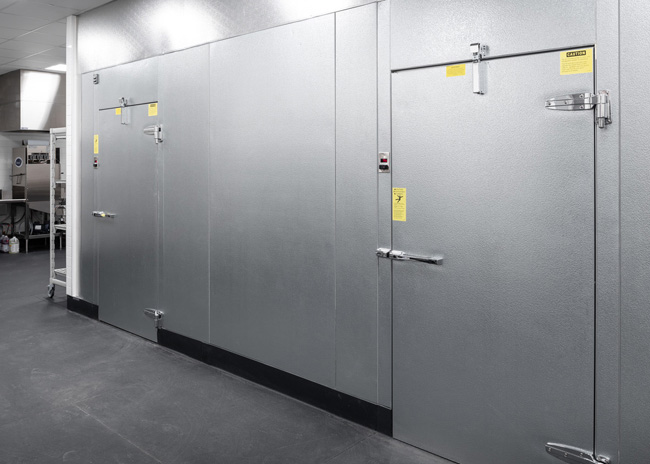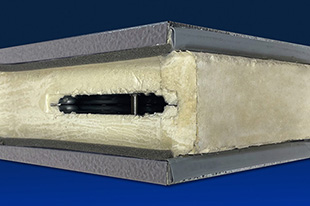Walk-in coolers might appear indistinguishable from the outside, but it's the interior that truly matters. Among the factors influencing performance, few are as impactful as panel insulation. However, insulation comes in various types, each differing in efficiency.

Considering that panel insulation significantly influences the total cost of ownership, opting for a manufacturer employing the most efficient insulation type is a logical choice.
This article delves into the comparison between two primary insulation materials: polyurethane and polystyrene. While both offer distinct merits and demerits, a definitive frontrunner emerges from the analysis.
Try Our Savings Calculator:
What walk-in cooler insulation saves you the most? Of the two major types, polyurethane and polystyrene, polyurethane is the better choice.
See for yourself. Try our Savings Calculator and learn how much you can save with polyurethane panels.
Walk-In Panel Insulation Types
As highlighted, two prevailing insulation materials in use are polyurethane and polystyrene. Polystyrene, in particular, can be categorized into Expanded Polystyrene (EPS) and extruded polystyrene (XPS).
EPS is produced by expanding small polystyrene beads within a mold, where heat and pressure amalgamate them into the desired panel shape. These beads create closed cells but exhibit substantial open spaces between them. A familiar example of EPS is Styrofoam.
On the other hand, XPS is generated by injecting liquid polystyrene plastic into an extrusion mold, resulting in a foam panel. While XPS also consists of closed cells, it possesses a denser composition than EPS. Additionally, XPS is generally acknowledged for its superior insulation quality compared to EPS.
Polyurethane foam is a composite of two chemicals known as isocyanurates and polyols. Typically, these chemicals are introduced into a flat fixture or mold. Their interaction triggers a swift and steady expansion, effectively filling the fixture and shaping the panel.
Polyurethane Insulation Pros & Cons
 Polyurethane's heat resistance saves energy, lowers refrigeration costs by reducing workload
Polyurethane's heat resistance saves energy, lowers refrigeration costs by reducing workload
Any discussion of polyurethane or polystyrene must begin with R-value. Stated simply, R-value is the capacity of an insulating material to resist heat flow. The higher the R-value, the greater the insulating ability.
Polyurethane’s greater heat-resistant properties mean a refrigeration system doesn’t have to work as hard to keep inside air cold, which saves energy and, in turn, operating costs.
In fact, polyurethane panels typically have an R-value of 32 which meets or surpasses DOE regulations.
Other advantages include:
- Permanently adheres to metal panels, enhancing strength and reliability
- Superior moisture resistance due to polyurethane’s 97% closed-cell content
- Allows for maximum walk-in storage space due to thinner walls relative to other foam options
- Classified as a thermoset material, polyurethane resists melting and is UL Class 1-rated for fire resistance
An often-cited drawback of polyurethane is its gradual R-value decline over time. It's important to note that both polystyrene and polyurethane experience diminishing R-values as years pass. With polyurethane, this decline is often linked to exposure to external elements, but in practical applications, polyurethane-foamed panels are mostly enclosed and shielded from such exposure.
Polystyrene Insulation Pros & Cons
Polystyrene panels may incur lower upfront costs than polyurethane, and they possess lighter weight and easier handling. They also exhibit commendable resistance to water and airflow.
However, the relatively lower R-value of polystyrene translates to higher operational expenses over time. To achieve an R-value equivalent to polyurethane, thicker wall structures are required, consequently reducing available walk-in storage capacity.
Other polystyrene disadvantages include:
- Limited resistance to ultraviolet radiation
- Subpar resistance to chemicals including organic solvents
- Dependency on hard-nose construction types with edges fashioned from wood or high-density foam rails. These edges are less insulating and don’t seal as thoroughly as soft nose panels, where the edges are made of the same polyurethane foam as the rest of the panel.
Conclusion
While you can spend less upfront for a walk-in with cheaper insulation, you pay for it in the end with higher operating costs. When planning your next walk-in, remember what’s inside really counts, so make sure you use the most efficient solution for your business.






